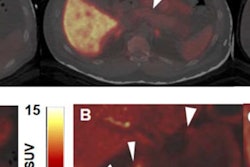
CHICAGO - Patients with diabetes who also have mild coronary artery disease have a similar risk of major cardiac events as diabetic patients with single-vessel obstructive disease, researchers from Canada reported at RSNA 2014.
"Patients identified with mild disease on CT may benefit from more aggressive medical therapy than they are currently receiving," suggested study co-author Dr. Philipp Blanke, a radiologist at the University of British Columbia and St. Paul's Hospital in Vancouver.
Previous two-year studies had suggested that diabetic patients with mild or nonobstructive coronary artery disease had a lower risk of major adverse coronary events than patients who were diagnosed with one major blockage in a coronary artery.
"Our five-year follow-up data suggest that nonobstructive and obstructive coronary artery disease as detected by cardiac CT angiography in diabetic patients are both associated with higher rates of mortality," according to Blanke, who discussed the study at a press conference.
Diabetic patients who did not have any disease findings at CT angiography had a significantly better prognosis and significantly lower rates of major events at five years. Approximately 25% of patients with diabetes who underwent CT angiography due to clinical findings or symptoms did not have coronary artery disease.
The researchers analyzed data from the Coronary CT Angiography Evaluation for Clinical Outcomes: An International Multicenter (CONFIRM) Registry, which was developed to examine the prognostic value of cardiac CT angiography for predicting adverse cardiac events related to coronary artery disease.
Of the 34,000 patients enrolled in the registry, 12,086 had at least five years of follow-up. Patients in the registry were enrolled from Austria, Canada, Germany, Israel, Italy, Portugal, South Korea, Switzerland, and the U.S. The current analysis included 1,823 patients diagnosed with diabetes.
The researchers defined three categories of coronary artery disease: none, meaning there was no evidence of coronary stenosis; mild, indicating 1% to 49% nonobstructive stenosis; and obstructive, meaning greater than 50% stenosis.
Blanke said 24.3% of the patients had "normal" coronary arteries. Meanwhile, 23.3% were classified as having mild stenosis, 23.8% had obstructive disease in one artery, 13.1% had obstructive disease in two arteries, and 15.5% had three-vessel coronary artery disease.
In the risk-adjusted analysis, the hazard ratio for diabetic patients with mild disease was 2.0. Those with one obstructed blood vessel had a hazard ratio of 2.1. Both were significantly higher risk (p < 0.001 for mild disease; p = 0.003 for obstructive disease) when compared with patients who had so-called normal coronary arteries. The death rate in that group was 1.2% per year; overall, the annualized death rate was 2.7%.
After five years, approximately 95% of diabetic patients with normal arteries were alive, about 90% of those with mild or one-vessel disease were alive, and about 80% of those with two- or three-vessel disease were alive, Blanke explained.
"These results may be a teaching moment for doctors who can use them to tell their diabetic patients that aggressively treating their disease is important -- even if they just have 'mild' disease," press conference moderator Dr. Max Wintermark, a professor of radiology at Stanford University, told AuntMinnie.com.
Study co-author Dr. Jonathan Leipsic, vice chairman of the department of radiology at the University of British Columbia, said researchers need a better understanding of the evolution of plaque in the arteries and patient response to therapies.
"Cardiac CT angiography is helpful for identifying diabetic patients who are at higher risk for heart events, who may benefit from more aggressive therapy to help modify that risk," he said.




















